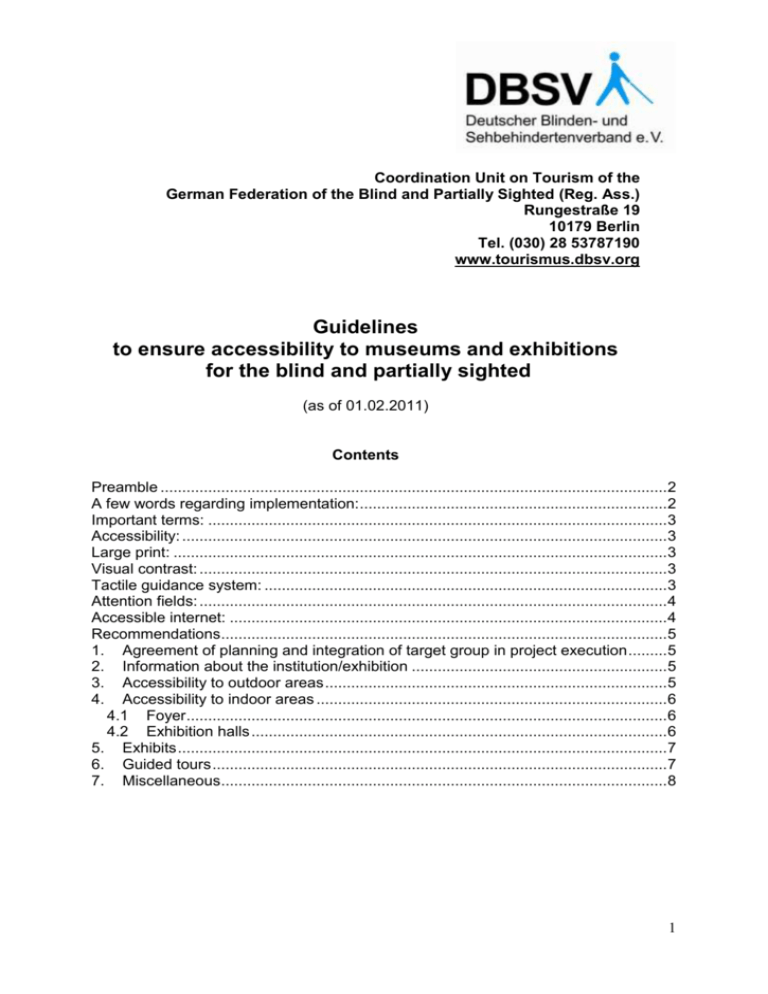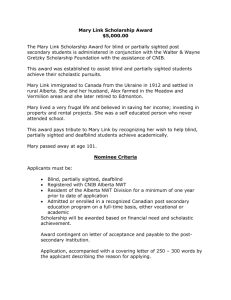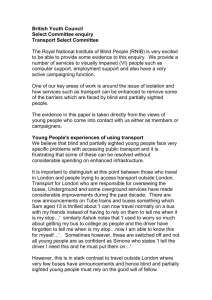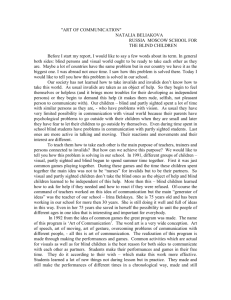6. Guided tours
advertisement

Coordination Unit on Tourism of the German Federation of the Blind and Partially Sighted (Reg. Ass.) Rungestraße 19 10179 Berlin Tel. (030) 28 53787190 www.tourismus.dbsv.org Guidelines to ensure accessibility to museums and exhibitions for the blind and partially sighted (as of 01.02.2011) Contents Preamble ..................................................................................................................... 2 A few words regarding implementation: ....................................................................... 2 Important terms: .......................................................................................................... 3 Accessibility: ................................................................................................................ 3 Large print: .................................................................................................................. 3 Visual contrast: ............................................................................................................ 3 Tactile guidance system: ............................................................................................. 3 Attention fields: ............................................................................................................ 4 Accessible internet: ..................................................................................................... 4 Recommendations....................................................................................................... 5 1. Agreement of planning and integration of target group in project execution ......... 5 2. Information about the institution/exhibition ........................................................... 5 3. Accessibility to outdoor areas ............................................................................... 5 4. Accessibility to indoor areas ................................................................................. 6 4.1 Foyer............................................................................................................... 6 4.2 Exhibition halls ................................................................................................ 6 5. Exhibits ................................................................................................................. 7 6. Guided tours ......................................................................................................... 7 7. Miscellaneous....................................................................................................... 8 1 Preamble Cultural tourism plays an important role in efforts to integrate the blind and partially sighted in society. This is particularly stressed by Article 30 of the United Nations Convention on the Rights of People with Disabilities, ratified by Germany in 2008 and the EU in 2010. A visit to a museum, whether of art, local history or technology, is just as worthwhile for the blind and partially sighted as it is for visitors without visual impairments. In order to make it easier for the blind and partially sighted to visit museums and exhibitions autonomously, the Coordination Unit on Tourism of the German Federation of the Blind and Partially Sighted (Reg. Ass.) took the public discussion on this topic into consideration and then proceeded to make the following recommendations at its annual conference in Essen in 2010. Implementation of these recommendations makes visiting museums and exhibitions easier not only for the blind and partially sighted, but for many others besides, not least the growing proportion of elderly people within the population. In this respect they also represent a contribution to achieving more social and economic sustainability by developing provisions for specific target groups. A few words regarding implementation: These recommendations are very comprehensive. We are aware that it might not be possible to realise all of them in detail. And yet the more extensively the recommendations are implemented, the more autonomously the blind and partially sighted will be able to take advantage of museums. This does not mean that educational provisions already made by museums for this target group should be underestimated or even become superfluous. They will remain a valuable addition even after these recommendations have been implemented, but they will never be a substitute for them. The recommendations set out here for museums and exhibitions should ideally be taken into account from the earliest planning stages. Likewise, museum education officers and special providers should pay them attention from the outset. However, if for whatever reason this has not occurred, the recommendations can also be implemented later, step by step, e.g. in conjunction with maintenance work and repairs. We have endeavoured to make these recommendations as brief as possible. For readers who are unfamiliar with this topic, this can sometimes make them harder to understand. However, should any problems of understanding emerge, our guiding principle of involving the regional branches of the Self-Help Group for the Blind and Partially Sighted or the Coordination Unit on Tourism of the German Federation of the Blind and Partially Sighted (Reg. Ass.)1 or an 1 http://www.tourismus.dbsv.org 2 advisory body such as the National Coordination Board on Tourism For ALL2 in the planning and installation of accessible museums and exhibitions means that they should be quick and easy to solve. Important terms: Accessibility: In equality law, accessibility describes the state of zones which are designed to enable all people, regardless of disability, to use them in the usual way, without any particular difficulties and where possible without the help of a third person. This term is therefore concerned not only with architectural obstacles, which primarily hinder people with a walking disability. For the blind and partially sighted, the greatest obstacles to mobility are a lack of orientation and guidance systems, as well as interior designs low in contrast. An additional essential element for accessibility to museums and exhibitions is the adequate presentation of information. The following design and orientation features are therefore particularly important for blind and partially sighted visitors and are mentioned accordingly frequently in the recommendations: Large print: The partially sighted find it significantly easier to read a sans-serif font (without embellishment), such as Arial, Verdana or Helvetica. The type size should not be too small (at least 12 point) and should contrast well with the background. Visual contrast: For good visual perception, adjacent surfaces should differ not only in colour, but also in shade. For people with partial or total colour blindness, this light/dark contrast is extremely important. Matching or similar colours, such as light blue and dark blue or light green and dark green, should therefore be avoided. The colour combination red/green is completely unsuitable (approx. 9% of the population suffer from a red-green colour blindness). Tactile guidance system: 2 NatKo is a non-profit amalgamation of various self-help associations for the disabled, including the German Federation of the Blind and Partially Sighted (Reg. Ass.) (www.natko.de). 3 Blind people, especially when they are in unfamiliar locations, like to orientate themselves along tactile guidance lines to the right and left of their path using their white canes. Outdoors, orientation can be provided by an upstanding edge along the right and left of the path. Indoors, tactile orientation might take the form of different types of flooring. A suitable example of this would be a change from tiles to laminate or from carpet (or rugs) to wood. The “guidance” thus provided imparts a tactile and at the same time acoustic message when swept with a cane. This type of orientational aid can be a harmonious part of the interior design and need not be perceived by other visitors as a “consciously designed” guidance system. Attention fields: Wherever the guidance system leads visitors to an “obstacle” (stairs, static installations), an “attention field” which is significantly distinct from the surrounding flooring, both tactually and optically, should be placed immediately in front of it.3 Alternatively, the guidance system should lead visitors around the obstacle. Accessible internet: A website is accessible for the blind and partially sighted if its type colours and sizes can be changed at will, and if it can be read and activated using computer aids for the blind (voice output or a Braille version). Important functions include operability exclusively via the keyboard (no mouse!), as well as the furnishing of all graphical elements with “alternative text“.4 3 The recommended positioning of attention fields in front of static elements is a height of 60-90 cm and over a width corresponding to that of the obstacle in question (for stairs as wide as the whole staircase). 4 For further information see www.bik-online.info. 4 Recommendations for the design of museums and exhibitions to ensure accessibilty for the blind and partially sighted 1. Agreement of planning and integration of target group in project execution As mentioned in the preamble, regional organisations such as the SelfHelp Group for the Blind and Partially Sighted and the Coordination Unit on Tourism of the German Federation of the Blind and Partially Sighted (Reg. Ass.)5 or a competent advisory service such as the National Coordination Board on Tourism For ALL6 should be involved in the planning and installation of museums and exhibitions from the outset. An “accessibility coordinator” should be nominated during the preparation phase to act not only as an external contact partner, but also as an internal coordinator of all accessibility measures. 2. Information about the institution/exhibition All information should be presented via at least one of the following media: accessible website (where appropriate with downloadable text or audio files), Braille, large print or audio CD, audioguide (with additional information for the blind and partially sighted). 3. Accessibility to outdoor areas 5 6 The museum or exhibition ground should be easy to reach by public transport. The route from the nearest stop to the entrance should be marked with tactile guidance stripes which contrast well with the surroundings, terminating in an attention field at the main entrance. http://www.dbsv.org/dbsv/unsere-struktur/dbsv-gremien/tourismus/ www.natko.de 5 4. Accessibility to indoor areas7 4.1 Foyer The entrance door should be in stark contrast to its surroundings. A revolving door should not be the only method of entry. Doors which consist of a single pane of glass without any (coloured) structure should have two sets of contrasting safety markings across the entire width of the door at a height of 40-70 cm and 120-160 cm. From the main entrance door, a contrasting and tactile guidance system8 should lead to the information desk or till, and from there to the lifts and stairs. The edges of steps and the thresholds of doorways should have safety markings across their entire width, contrasting well with the surroundings and approx. 4-5 cm thick. An overview showing the locations of the various exhibition halls should be available in embossed print with Braille information, as well as in large print against a contrasting background. A tactile and visually contrasting guidance system should lead from one exhibition space to the next. 4.2 Exhibition halls Information should be available for each exhibition hall about the exact location and arrangement of exhibits. This might take the form of an overview (embossed and large print) or of written or acoustic information. Within each hall, a tactile and visually contrasting guidance system should facilitate autonomous movement around the room and to the various exhibits. The labelling of the exhibits (including numbering for audioguides9) should be in well-contrasting large print and in Braille, mounted at eye level. 7 For outdoor exhibitions, the Empfehlungen zur barrierefreien Gestaltung von Spazierwegen und Lehrpfaden should also be adhered to (http://www.tourismus.dbsv.org). 8 As detailed in the preamble, an indoor guidance system can be created through the use of different (contrasting and tactually perceptible) floorings (stone/wood/carpet). For outdoor exhibitions, the Empfehlungen zur barrierefreien Gestaltung von Spazierwegen und Lehrpfaden (http://www.tourismus.dbsv.org) should be adhered to. 9 The option of choice for blind visitors is an audioguide which receives its information by radio signal when it approaches an exhibit fitted with a transmitter. 6 5. Exhibits 6. Exhibits which are too small or too large to be touched, or which cannot be touched for other reasons,10 should be provided as scaled up or scaled down copies. As an exception, the prohibition of photography should be waived for partially sighted visitors in possession of a digital camera since they chiefly use digital cameras as an aide to enlarge objects which would otherwise be invisible to them. For every exhibit (not least for paintings), additional information should be available for blind and partially sighted visitors in written and/or acoustic form.11 Guided tours The provision of guided tours especially for blind and partially sighted visitors is an important addition to a museum, but never a substitute for accessibility. Guided tours of this nature should ensure that information about the individual exhibits, especially those which cannot be touched, is not only general (scientific, historic, etc.), but also descriptive, in an attempt to compensate visitors for their lack of a visual impression. In particular, tour guides should mention the following points: the dimensions of the exhibit important structural features - - for sculptures this includes their external form; for models of people it includes their stance and clothing, as well as their facial expression where appropriate for paintings this includes the arrangement of individual elements and the colours used. 10 Thin gloves (e.g. latex or cotton) should be provided for touching delicate surfaces. For professional experience in conjunction with museums, including additional information for blind visitors, see e.g. Antenna Audio (www.antennaaudio.com) or Andersicht e.V. (www.andersicht.net). 11 7 7. Miscellaneous All audioguides and information terminals should - have contrasting and tactual buttons (no sensors, no touch screens) be operable exclusively via these buttons; any operation via menus must be voice-controlled. The use of synthetic speech may be considered. At least one member of staff trained in the use of these devices should be on hand to help visitors at all times. Guide dogs should be permitted to enter all buildings. 8






